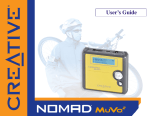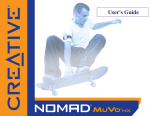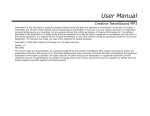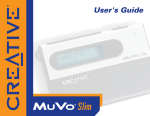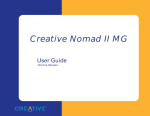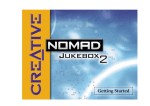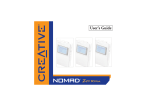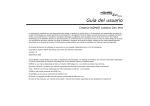Download Creative Nomad Muvo2 User`s guide
Transcript
User’s Guide Creative NOMAD MuVo² Information in this document is subject to change without notice and does not represent a commitment on the part of Creative Technology Ltd. No part of this manual may be reproduced or transmitted in any form or by any means, electronic or mechanical, including photocopying and recording, for any purpose without the written permission of Creative Technology Ltd. The software described in this document is furnished under a license agreement and may be used or copied only in accordance with the terms of the license agreement. It is against the law to copy the software on any other medium except as specifically allowed in the license agreement. The licensee may make one copy of the software for backup purposes only. The Software License Agreement is found in a separate folder on the Installation CD. Copyright © 2003 by Creative Technology Ltd. All rights reserved. Version 1.0 July 2003 The Creative logo and MuVo are registered trademarks, and Creative MediaSource is a trademark of Creative Technology Ltd. in the United States and/or other countries. NOMAD is a registered trademark of Aonix and is used by Creative Technology Ltd. and/or its affiliates under license. Microsoft, MS-DOS, Windows and the Windows logo are registered trademarks of Microsoft Corporation. Intel and Pentium are registered trademarks of Intel Corporation. All other products are trademarks or registered trademarks of their respective owners and are hereby recognised as such. All specifications are subject to change without prior notice. Actual contents may differ slightly from those pictured. Contents Contents Introduction Package Contents ........................................................................................................................................... i Minimum System Requirements ................................................................................................................ i Product Registration ..................................................................................................................................... ii Technical Support and Warranty ............................................................................................................. ii Online Updates .............................................................................................................................................. ii Optional Accessory ...................................................................................................................................... ii Document Conventions ............................................................................................................................. iii 1 Your Player At A Glance Front View .................................................................................................................................................. 1-1 Side View ..................................................................................................................................................... 1-2 Using the Sports Case and Armband ................................................................................................. 1-3 2 Getting Started Step 1: Charge Battery ............................................................................................................................ Step 2: Install Software ............................................................................................................................ Step 3: Transfer Songs ............................................................................................................................ Step 4: Play Songs ..................................................................................................................................... 2-1 2-2 2-3 2-5 3 Using Your Player Transferring Files ...................................................................................................................................... Using Windows Explorer ............................................................................................................ Using Creative MediaSource Organiser .................................................................................. Playing Songs .............................................................................................................................................. 3-1 3-1 3-2 3-2 Playing a song ................................................................................................................................... Playing an album .............................................................................................................................. Playing a playlist ............................................................................................................................... Playing recorded audio ................................................................................................................. Locking Your Player ................................................................................................................................. Deleting Songs ........................................................................................................................................... Recording Audio ....................................................................................................................................... Formatting Your Player .......................................................................................................................... Charging the Battery ............................................................................................................................... Creating and Managing Playlists ............................................................................................................ Creating a playlist ............................................................................................................................ Adding tracks to a playlist ............................................................................................................ Deleting a playlist ............................................................................................................................ 3-2 3-2 3-3 3-3 3-3 3-4 3-4 3-4 3-5 3-6 3-6 3-7 3-8 4 Setting Preferences Play mode .................................................................................................................................................. EQ ................................................................................................................................................................ Defining Custom EQ ..................................................................................................................... Settings ....................................................................................................................................................... 4-1 4-2 4-2 4-3 A LCD Guide Mode Overview ....................................................................................................................................... Music ................................................................................................................................................ Record ............................................................................................................................................. Play Status Icons ....................................................................................................................................... Information Diagrams ............................................................................................................................ A-1 A-1 A-1 A-2 A-3 B About Music Files Overview .................................................................................................................................................... B-1 Downloading from the Internet ................................................................................................. B-1 “Ripping” audio CDs ..................................................................................................................... B-1 C Frequently Asked Questions Installation .................................................................................................................................................. C-1 Usage ........................................................................................................................................................... C-2 Updates ....................................................................................................................................................... C-4 D Maintenance and Safety Advice E Specifications Introduction Introduction Thank you for choosing Creative NOMAD MuVo™2. Note that the name of this product may vary from country to country. Creative NOMAD MuVo2 player Power adapter Rechargeable Lithium-Ion battery USB 2.0 cable Headphones Protective case, or Sports Case and Armband* Installation CD Quick Start booklet Package Contents ❑ ❑ ❑ ❑ ❑ ❑ ❑ ❑ Minimum System Requirements ❑ Microsoft® Windows® 98 Second Edition (SE), Windows 2000, Windows Millennium * ❑ ❑ ❑ ❑ ❑ ❑ Edition (Me) or Windows XP Intel® Pentium® II 233 MHz, or AMD-K6®-2 266 MHz 32 MB RAM 30 MB available hard disk space CD-ROM/DVD-ROM drive USB port (USB 2.0 port recommended for faster transfer speeds) Internet access for Music Service Provider support (optional) The Sports Case and Armband are supplied with 512 MB Creative NOMAD MuVo2 players only. Introduction i Product Registration Enjoy a host of benefits by registering your product during installation, or at www.creative.com/register. Benefits include: ❑ Service and product support from Creative ❑ Exclusive updates on promotions and events Technical Support and Warranty Technical Support information can be found on the Installation CD. Go to d:\Support\<Language>\Support.pdf Warranty information can be found on the Installation CD as well. Go to d:\Warranty\<Region>\<Language>\Warranty.pdf (replace d:\ with the drive letter of your CD-ROM/DVD-ROM drive, <Region> with the region that you are in and <Language> with the language that the document is in) Please keep your Proof of Purchase for the duration of the Warranty period. Online Updates Visit www.NOMADworld.com for the latest updates on: ❑ Firmware ❑ Software ❑ Documentation ❑ NOMAD accessories Optional Accessory The Creative FM Wired Remote (available separately) lets you access the controls of your player without having to take the player out of your bag. In addition, the FM Tuner stores up to 32 preset FM channels, and the built-in microphone lets you make voice recordings. You may need to download firmware that lets you use your player with the Creative FM Wire Remote. Visit www.NOMADworld.com for more details. Introduction ii Document Conventions This User’s Guide uses the following icons to highlight useful or urgent information. Tip. This tells you about short cuts or hints relating to a feature. Note. This highlights additional or important information about a feature. Caution! This highlights proper usage of your product. Use this information to avoid risky situations. Warning! This warns you of possible hazards to yourself or your product, that may result in injury or damage. Introduction iii 1 Your Player At A Glance Your Player At A Glance Front View LCD Press and hold this button to turn your player on and off. Figure 1-1 Press and hold to turn your player on and off. Press once to start playing tracks, and press again to pause playback. MENU Press to display Menu options on the LCD. Press again to select a Menu option. Press to skip to the next track, and press and hold to skip ahead within track. Press to skip to the previous track, and press and hold to skip back within a track. Press and to browse Menu options on the LCD. Press to increase or to decrease the volume. Your Player At A Glance 1-1 Side View For your safety and the safety of others, do not use headphones while driving or cycling. Figure 1-2 Connects to a power outlet using the supplied power adapter. You may need to download firmware that lets you use your player with the Creative FM Wire Remote. Visit www.NOMADworld.com for more details. Connects to your computer’s USB port using the supplied USB cable. Connects to headphones, or the Creative FM Wired Remote (available separately). Your Player At A Glance 1-2 Using the Sports Case and Armband The Sports Case and Armband are supplied with 512 MB Creative NOMAD MuVo2 players only. 1 2 3 4 Figure 1-3 Your Player At A Glance 1-3 2 Getting Started Getting Started Step 1: Charge Battery 1. Insert the supplied battery into your player. Figure 2-1 Getting Started 2-1 2. Connect your player to a power outlet using the supplied power adapter. will appear on your player’s LCD. Figure 2-2 3. Step 2: Install Software Charge the battery until appears on your player’s LCD. Charging your battery for the first time will take about 3 hours. DO NOT connect your player to your computer before installing the software. 1. Insert the Installation CD into your CD-ROM/DVD-ROM drive. The disc supports Windows Autoplay mode and starts running automatically. If not, you need to enable the Windows auto-insert notification feature for your CD-ROM/DVD-ROM drive. For more details, see “Installation” on page C-1. 2. Follow the instructions on the screen to complete the installation. Creative MediaSource™ and Windows 98 SE drivers (only if applicable) will be installed on your computer. 3. When prompted, restart your computer. Getting Started 2-2 Step 3: Transfer Songs 1. Connect your player to your computer’s USB port using the supplied USB cable. Your computer’s USB port may be located on the front panel. Figure 2-3 2. Launch Windows Explorer on your computer. Your player is recognised as a Removable Disk in Windows Explorer. 3. Transfer MP3 or WMA files to your player using a drag-and-drop operation. Figure 2-4 Getting Started 2-3 4. After the transfer is complete, make sure you stop your player before disconnecting it from your computer. To stop your player in Windows 98 SE In Windows Explorer, right-click the Removable Disk icon, click the Eject option, and disconnect your player when you are prompted to do so. Figure 2-5 To stop your player in Windows 2000, Windows Me or Windows XP Click the Safely Remove Hardware icon on the Taskbar, click Safely remove USB Mass Storage Device, and disconnect your player when you are prompted to do so. Figure 2-6 Getting Started 2-4 5. For more advanced song management tasks, such as creating and managing playlists, you can use Creative MediaSource Organiser. Creative MediaSource Player/Organiser is your digital music center for playing, creating, organizing and transferring digital music. To launch Creative MediaSource Player/ Organiser, double-click the Creative MediaSource Player/Organiser icon (Figure 2-7) on your desktop. Figure 2-7 For more information about using Windows Explorer, refer to its online Help. For more information about using Creative MediaSource, refer to its online Help. For more information about transferring songs, see “Transferring Files” on page 3-1. Step 4: Play Songs Remember to set the volume at a moderate level. Listening to music at high volumes can impair your hearing. 1. Press and hold until your player turns on. 2. Press to start playing the songs that you transferred to your player. 3. Press to increase or 4. After you have finished using your player, press and hold turns off. to decrease the volume. until your player Getting Started 2-5 3 Using Your Player Using Your Player Transferring Files You can use your player as a portable storage device to store any data type, from documents to presentations and photos. Using Windows Explorer For more information about using Windows Explorer, refer to its online Help. You can use either Windows Explorer or Creative MediaSource Organiser to transfer files from your computer to your player. Only MP3 and WMA files, however, can be viewed and played back on your player. For more information about music files, see “About Music Files” on page B-1. Note: If you are using Windows 98 SE, you will need to install the Windows 98 SE drivers from the Installation CD before you can transfer files. For instructions on installing these drivers, see “Step 2: Install Software” on page 2-2. 1. Connect your player to your computer’s USB port using the supplied USB cable. 2. Launch Windows Explorer on your computer. Your player is recognised as a Removable Disk in Windows Explorer. 3. Transfer files to your player using a drag-and-drop operation. 4. After the transfer is complete, make sure you stop your player before disconnecting it from your computer. See “Usage” on page C-2 for instructions on stopping your player. Using Your Player 3-1 Using Creative MediaSource Organiser Creative MediaSource Organiser also lets you create and manage playlists in your player. See “Creating and Managing Playlists” on page 3-6. 1. Connect your player to your computer’s USB port using the supplied USB cable. 2. Launch Creative MediaSource Organiser by clicking the Creative MediaSource Player/Organiser icon on your desktop. 3. If you are not already in Creative MediaSource Organiser, click the Player/Organiser View button. 4. Click the Show/Hide Right Panel button. 5. In the Sources window, select the disk drive where your file is located. 6. In the Content window, select the file you want to transfer. CTRL-click to select multiple files. 7. In the Right Panel window, click the Source bar and select your player's icon. 8. Click the Left-to-Right Transfer button, or transfer the selected files from the Content window to the Right Panel window using a drag-and-drop operation. 9. The Now Transferring dialog box appears, showing the current transfer status. 10. After the transfer is complete, make sure you stop your player before disconnecting it from your computer. See “Usage” on page C-2 for instructions on stopping your player. Playing Songs Playing a song Playing an album 1. Press MENU. 2. Press 3. Press MENU to select this option. 4. Browse to a song that you want to play and press 1. Press MENU. and to browse to the Music option. . Using Your Player 3-2 Playing a playlist Playing recorded audio Locking Your Player 2. Press and 3. Press MENU to select this option. 4. Browse to the Folder (Root) option, and press MENU to browse for tracks organised according to folder names. 5. Browse to an album that you want to play and press 1. Press MENU. 2. Press 3. Press MENU to select this option. 4. Browse to the Playlist option, and press MENU to browse for tracks organised according to file names. 5. Browse to a playlist that you want to play and press 1. Press MENU. 2. Press 3. Press MENU to select this option. 4. Press 5. Press MENU to select this option. 6. Browse to a recording that you want to play and press and and and to browse to the Browser option. to browse to the Browser to browse to the Browser to browse to the Voice . option. . option. option. . Lock your player when you want to prevent buttons from being accidently pressed, such as when your player is in your pocket or bag. 1. Press MENU. 2. Press and to browse to the Lock option. 3. Press MENU to select this option. will appear at the top right corner of the LCD. Using Your Player 3-3 Deleting Songs 4. To unlock your player, press MENU, browse to the Unlock press MENU. 1. Press MENU. 2. Press 3. Browse to and to browse to the Delete option, and option. and press MENU to permanently delete the current song. For more song management functions, use Creative MediaSource Organiser. For more information about using Creative MediaSource, refer to its online Help. Recording Audio You may need to download firmware that lets you use your player with the Creative FM Wire Remote. Visit www.NOMADworld.com for more details. Formatting Your Player You can only record audio when the Creative FM Wired Remote (available separately) is connected to your player. 1. Press MENU. 2. Press and to browse to the Record option. 3. Press MENU to select this option. 4. Press to start recording, and press again to stop recording. The first recorded track is named 0001, the second recorded track is named 0002, the third recorded track is named 0003, and so on. If you need to format your player, backup the files in your player first. When you format your player, all songs and files will be deleted. By default, you player is already formatted. 1. Connect your player to your computer’s USB port using the supplied USB cable. 2. Launch Windows Explorer on your computer. Your player is recognised as a Removable Disk in Windows Explorer. Using Your Player 3-4 3. Right-click the Removable Disk icon, click the Format option, and follow the instructions on the screen to format your player. Figure 3-1 4. After the formatting is complete, make sure you stop your player before disconnecting it from your computer. See “Usage” on page C-2 for instructions on stopping your player. For more information about using Windows Explorer, refer to its online Help. Charging the Battery You can charge your battery by connecting your player to a power outlet using the supplied power adapter, or by connecting your player to your computer’s USB port using the supplied USB cable. The LCD may display one of the following icons to indicate the power status of the battery: The amount of playback time available depends on various factors, such as the type of headphones you are using. For more information, see “Usage” on page C-2. Battery is 100% full. Battery is 60% full. Battery is 30% full. Using Your Player 3-5 Battery is empty. Your player is running from electrical power only. Your player is running from electrical power and the battery is being charged. Your player is running from electrical power and the battery is completely charged. Creating and Managing Playlists Creative MediaSource Organiser lets you to create and manage playlists in your player. Playlists are saved as M3U files. For example, a playlist that you name “Favorites” will be saved as “Favorites.m3u”. Creating a playlist 1. Connect your player to your computer’s USB port using the supplied USB cable. 2. Launch Creative MediaSource Organiser by clicking the Creative MediaSource Player/Organiser icon on your desktop. 3. If you are not already in Creative MediaSource Organiser, click the Player/Organiser View button. 4. Click the Show/Hide Right Panel button. 5. In the Sources window, select your player's icon. The contents of your player are displayed in the Content window. 6. Click the New Playlist button, enter a name for the new playlist and click the OK button. A new empty playlist is displayed in the Content window. M3U files only list the names and order of music files, and do not actually contain any music files. As such, when you create a playlist in your player, Creative MediaSource Organiser will transfer the music files listed in the playlist to your player. Using Your Player 3-6 7. In the Right Panel window, click the Source bar and select your player's icon if you want to add tracks that are in your player. 8. To add tracks that are located elsewhere, select the corresponding icon. For example, if you want to add tracks from PC Music Library, select the PC Music Library icon. 9. Select the track you want to transfer. CTRL-click to select multiple tracks. 10. Click the Right-to-Left Transfer button, or drag-and-drop the selected tracks from the Right Panel window to the Content window. 11. If the tracks that you add to a playlist are not already in your player, they will be transferred to your player. Adding tracks to a playlist 1. Connect your player to your computer’s USB port using the supplied USB cable. 2. Launch Creative MediaSource Organiser by clicking the Creative MediaSource Player/Organiser icon on your desktop. 3. If you are not already in Creative MediaSource Organiser, click the Player/Organiser View button. 4. Click the Show/Hide Right Panel button. 5. In the Sources window, select the PLAYLIST folder listed under your player's icon. All existing playlists in your player are displayed in the Content window. 6. Double-click the playlist that you want to add tracks to. 7. In the Right Panel window, click the Source bar and select your player's icon if you want to add tracks that are in your player. 8. To add tracks that are located elsewhere, select the corresponding icon. For example, if you want to add tracks from PC Music Library, select the PC Music Library icon. 9. Select the track you want to transfer. CTRL-click to select multiple tracks. Using Your Player 3-7 10. Click the Right-to-Left Transfer button, or drag-and-drop the selected tracks from the Right Panel window to the Content window. 11. If the tracks that you add to a playlist are not already in your player, they will be transferred to your player. Deleting a playlist 1. Connect your player to your computer’s USB port using the supplied USB cable. 2. Launch Creative MediaSource Organiser by clicking the Creative MediaSource Player/Organiser icon on your desktop. 3. If you are not already in Creative MediaSource Organiser, click the Player/Organiser View button. 4. In the Sources window, click the PLAYLIST folder listed under your player's icon. 5. All existing playlists in your player are displayed in the Content window. 6. Right-click the playlist that you want to delete and select the Delete option. 7. After the deleting is complete, make sure you stop your player before disconnecting it from your computer. See “Usage” on page C-2 for instructions on stopping your player. Using Your Player 3-8 4 Setting Preferences Setting Preferences Play mode 1. Press MENU. 2. Press 3. Press MENU to select this option. 4. Browse to one of the following options, and press MENU to select it: • Repeat track Repeats the current song. When you select this, will appear at the top right corner of the LCD. • Repeat all Repeats all songs in your player. When you select this, will appear at the top right corner of the LCD. • Track once Stops playing after the current song ends. When you select this, will appear at the top right corner of the LCD. and to browse to the Play mode option. • Shuffle repeat Plays and repeats all songs, in random order. When you select this, appear at the top right corner of the LCD. • Shuffle once Plays all songs in random order, once only. When you select this, appear at the top right corner of the LCD. • Normal Resumes playing songs in sequence. will will Setting Preferences 4-1 EQ EQ is a collection of equaliser settings that can enhance the sound of your music. Select preset settings such as Rock or Jazz, or customise your own setting. 1. Press MENU. 2. Press 3. Press MENU to select this option. 4. Browse to one of the following options, and press MENU to select it: and to browse to the EQ • Rock When you select this, • Pop When you select this, option. will appear at the top right corner of the LCD. will appear at the top right corner of the LCD. • Classical When you select this, will appear at the top right corner of the LCD. • Jazz When you select this, will appear at the top right corner of the LCD. • Custom When you select this, will appear at the top right corner of the LCD. • Normal Plays songs without EQ enhancements. Defining Custom EQ 1. Browse to the Custom 2. Four vertical control levers will appear in the LCD, each lever controlling successively higher frequencies. 100 controls the bass, 800 adjusts the lower midrange, 3k adjusts the upper mid-range, and 12k adjusts the treble. 3. Browse to a control level, and press MENU to select it. 4. Press and option, and press MENU to select it. to adjust the levels. Setting Preferences 4-2 Settings 5. Browse to , and press MENU to confirm the Custom EQ setting and select this EQ option. 1. Press MENU. 2. Press 3. Press MENU to select this option. 4. Browse to one of the following options, and press MENU to select it: • Contrast Adjusts the contrast of the LCD. • Backlight Adjusts backlight duration. and to browse to the Settings option. • Language Sets the default language displayed on the LCD. • Idle shutdown Adjusts how long your player remains inactive before it automatically shuts down. • Information Displays your player’s firmware version, total memory space and available memory space. Setting Preferences 4-3 A LCD Guide LCD Guide Mode Overview Music Play Mode icon Elapsed time Play Status icon Music icon EQ icon Lock icon Battery Status icon Current track/ Total tracks Track title Record Lock icon Elapsed time Battery Status icon Available memory Record icon Recording status bar Available recording time LCD Guide A-1 Play Status Icons Play status icons appear at the left side of the LCD. Play Pause Skip forward within track Skip back within track Next track Previous track LCD Guide A-2 Information Diagrams The following information diagrams may appear on the LCD. Player is connected to your computer. To use your player, disconnect it from your computer. Files are being transferred to your player. DO NOT disconnect your player. Corrupted recorded voice file. Check that your recorded voice file is not corrupted, or reformat your player. Unsupported file format. Check that the file you are trying to play back is an MP3, WMA or recorded voice file. Unexpected power loss while saving settings. Download a newer firmware version, reload the firmware, or contact Technical Support for more assistance. Hardware problems. Contact Technical Support for more assistance. Low memory space. Delete some files to free up memory space in your player. Low battery power. Charge the battery. Battery flat. Charge the battery. LCD Guide A-3 B About Music Files About Music Files Overview You can download music files from Internet music sites, or “rip” music files from audio CDs to your computer. Music files that you transfer to your player must, however, be MP3 or WMA files if you want to play them back. MP3 and WMA files are music files that have lossy compression encoding, which means that some data is lost during compression. However, using standard sampling rates and bitrates will ensure that your MP3 files retain much of their audio quality. The standard bitrate of most MP3 files is 128 Kbps, although some are set higher, at 160 or 192 Kbps. The standard bitrate for most WMA files is 64 Kbps. Higher bitrates will result in better audio quality, but file sizes will be larger as a consequence. Downloading from the Internet To get MP3 files from the Internet, use a search engine to locate sites with MP3 content. You can also try out these sites (web sites listed here are correct at the time of this document’s release): ❑ NOMADWorld (http://www.NOMADworld.com) ❑ AMP3.com (http://www.amp3.com) ❑ SoundClick.com (http://www.soundclick.com) ❑ ArtistOne.com (http://www.artistone.com) ❑ Epitonic.com (http://www.epitonic.com) ❑ Soundbuzz.com (http://www.soundbuzz.com) Follow the instructions on the sites to download the music files to your computer. “Ripping” audio CDs The first phase of “ripping” is extracting audio data (usually WAV files) from an audio CD. Encoding is the second phase, where the audio data is converted into MP3 or WMA files. To “rip” audio CDs, you will need a CD-ROM/DVD-ROM drive that can extract digital audio data, and a program such as Creative MediaSource Organiser that can extract and encode this data. With Creative MediaSource Organiser, you can “rip” most audio CDs, as well as organise and transfer these “ripped” files. About Music Files B-1 The time needed for a successful audio extraction depends on: ❑ CD-ROM/DVD-ROM drive speed ❑ defects, like scratches on the audio CD ❑ error-checking features on the CD-ROM/DVD-ROM drive To rip an audio CD using Creative MediaSource Organiser 1. Insert an audio CD into your CD-ROM/DVD-ROM drive. 2. Launch Creative MediaSource Organiser by clicking the Creative MediaSource Player/Organiser icon on your desktop. 3. If you are not already in Creative MediaSource Organiser, click the Player/Organiser View button. 4. In the Sources window, select [d:] Audio CD (replace d: with your CD-ROM/DVD-ROM drive). 5. In the Task bar, click the Rip Now button. For more information about using Creative MediaSource, refer to its online Help. About Music Files B-2 C Frequently Asked Questions Frequently Asked Questions This section covers common problems you might encounter or questions you might have while using your player. If you have a technical problem with this product, you may wish to consult our self-help tool “Knowledgebase” for online troubleshooting and solutions. Go to www.creative.com and select your region. Installation What do I do when the installation does not start automatically after the Installation CD is inserted? The AutoPlay feature in your Windows system may not be enabled. To start the installation program through the My Computer shortcut menu 1. On your Windows desktop, double-click the My Computer icon. 2. Right-click the CD-ROM/DVD-ROM drive icon, and then click AutoPlay. 3. Follow the onscreen instructions. To enable AutoPlay through Auto Insert Notification 1. Click Start -> Settings -> Control Panel. 2. Double-click the System icon. The System Properties dialog box appears. 3. Click the Device Manager tab and select your CD-ROM drive. 4. Click the Properties button. 5. Click the Settings tab, and then select Auto Insert Notification. 6. Click the OK button. To start the installation program through Windows Explorer 1. In Windows Explorer, search and locate the d:\ctrun folder (replace d:\ with the drive letter of your CD-ROM/DVD-ROM drive). 2. Double-click the ctrun.exe file. Frequently Asked Questions C-1 Usage Why does the player skip certain tracks? The player will only play valid media formats (MP3 and WMA files). Other types of media formats will be skipped. Why are some files/tracks corrupted when transferred to the player? Transfer may have been interrupted. Before disconnecting your player from your computer, stop your player first. To stop your player in Windows 98 SE In Windows Explorer, right-click the Removable Disk icon, click the Eject option, and disconnect your player when you are prompted to do so. To stop your player in Windows 2000, Windows Me or Window XP Click the Safely Remove Hardware icon on the Taskbar, click Safely remove USB Mass Storage Device, and disconnect your player when you are prompted to do so. Why does the player turn off immediately after it is turned on? The batteries may be too depleted to power your player. Try charging the battery. Frequently Asked Questions C-2 File transfers to the player are very slow (less than 100 KB/Sec). What do I do? Try formatting your player. For more information, refer to “Formatting Your Player” on page 3-4. Can I use the Creative NOMAD MuVo 2 as a portable data storage device? Yes, you can. For more information, refer to “Transferring Files” on page 3-1. Can I jog with the Creative NOMAD MuVo 2? Yes, but only if you are using the 512 MB Creative NOMAD MuVo2 player. Other models have hard disk drives that may be damaged during vigorous activities like jogging. I have to charge the battery quite often. Is there anything I can do to make it last longer? ❑ Set a shorter idle shutdown time. ❑ Set a lower contrast setting. ❑ Avoid skipping ahead and back within tracks unnecessarily. ❑ Avoid turning the player on and off unnecessarily. ❑ Avoid using passive speakers or high-powered headphones. ❑ Avoid playing back WMA files. Should I leave my player plugged into the power adapter? No, you should not. After charging the battery or using the player, disconnect it from the power adapter. Leaving it plugged in leads to heat buildup, which is not good for the player or the battery. If I damage or lose my power adapter, can I buy a similar, off-theshelf adapter? No. The power adapter may not be compatible with your player, and may even damage it. You should get a replacement adapter from Creative at www.NOMADworld.com, or your local Creative office/distributor. Frequently Asked Questions C-3 Updates Where can I get official information on all NOMAD products? Visit NOMADworld (www.NOMADworld.com) for updates and downloads relating to all NOMAD products, Creative’s MP3 players and accessories. Frequently Asked Questions C-4 D Maintenance and Safety Advice Maintenance and Safety Advice Player ❑ ❑ ❑ ❑ ❑ ❑ ❑ ❑ ❑ Battery ❑ ❑ ❑ ❑ ❑ ❑ ❑ ❑ ❑ Store away from direct sunlight. Do not expose to heat or fire. Avoid using or storing in surroundings that exceed 45°C (113°F). Keep away from excessive moisture. Do not subject to excessive force or impact. Do not modify or disassemble. Only clean the product with a soft dry cloth. Do not use liquid cleaners. Only qualified personnel should repair or service the product. Do not use the 1.5 GB Creative NOMAD MuVo2 player during vigorous activities like jogging. ❑ Remember to set the volume at a moderate level. Listening to music at high volumes can impair your hearing. ❑ Do not use headphones while driving or cycling. Store away from direct sunlight. Do not expose to heat or fire. Avoid using or storing in surroundings that exceed 45°C (113°F). Keep away from excessive moisture. Do not subject to excessive force or impact. Do not modify or disassemble. Avoid contact with metal objects. Do not pierce or crush. If there is leakage, stench, discolouration or deformation during charging or use, remove the battery and do not use it again. Clean your hands well before handling food or touching sensitive areas of your body, for example, your eyes. Maintenance and Safety Advice D-1 E Specifications Specifications Size (WxHxD) 66.5 mm (2.6") x 67.0 mm (2.6") x 20.0 mm (0.8") Weight 512 MB Creative NOMAD MuVo2 player: 65.2 g (2.3 oz) without battery; 87.9 g (3.1 oz) with battery 1.5 GB Creative NOMAD MuVo2 player: 70.9 g (2.5 oz) without battery; 90.7 g (3.2 oz) with battery LCD 132 x 32 pixel backlit display Storage Capacity 512 MB (flash memory) or 1.5 GB (HDD) Battery Life Up to 10 hours of continuous playtime Playback Formats MPEG Audio Layer 3 (MP3) and Windows Media Audio (WMA) Signal-to-Noise Ratio Up to 98 dB Harmonic Distortion Output <0.05% Frequency Response 20 Hz ~ 20 kHz Headphones Output 30 mW USB Connectivity USB 1.1 and USB 2.0 compatible Specifications E-1

















































